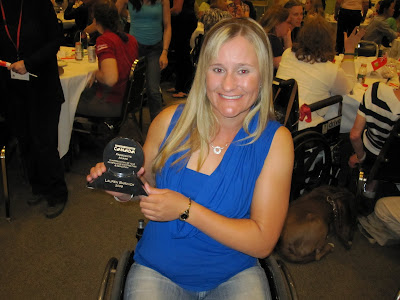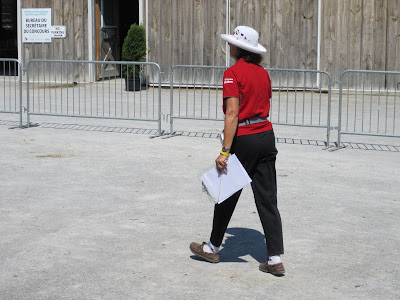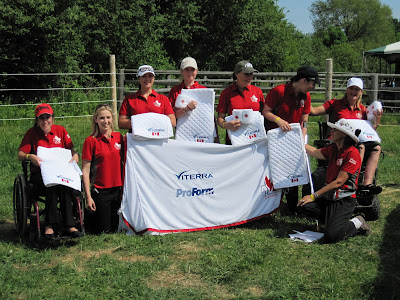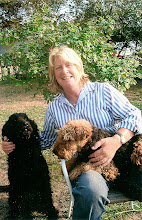At the welcome dinner last night at the Windreach PE competition Lauren Barwick was presented with the Equine Canada President's Award for 2009. She was being honoured for her work following her gold and silver medals at the Beijing Paralympics. As always she is very modest. She said that Para Equestrian success is all about firstly having the personal fire to succeed and then surrounding oneself with a very special team of dedicated people. Together they make the journey.
At the dinner Elizabeth Robinson was thanked for all her efforts as Chef d'Equipe for the Canadian team, and an organiser for this competition. She is always full of purpose and is great to work with as she is tireless, knowledgeable and full of enthusiasm and common sense - all necessary attributes to being a good 'chef'.
Photo time for the Canadian squad who really appreciate their sponsors.
Lovely weather, great organisation, perfect arena surface and a day when several riders achieving qualifying scores for WEG.
Friday, May 28, 2010
Tuesday, May 25, 2010
Cat Nap
What a wonderful ability to be able to 'take a nap' during Equine Canada PE training camp. Tomorrow horses move to the venue at Windreach.
Sunday, May 23, 2010
Layers of sound
Sitting on the balcony at the cottage above the Black River at Coopers Falls in Ontario is a treat. It is a therapy to the senses. No internet and no television adds to its charm.
The sights continually change as the water flows fast over the waterfall and rapids. There are layers of sound with the continual running river in the background and the birds busy feeding their babies in the trees.
The sky was full of insects. The dragonflies were attracted by the tablecloth. They are the most impressive piece of engineering and beauty with their lace-like double wings.



The sights continually change as the water flows fast over the waterfall and rapids. There are layers of sound with the continual running river in the background and the birds busy feeding their babies in the trees.
The sky was full of insects. The dragonflies were attracted by the tablecloth. They are the most impressive piece of engineering and beauty with their lace-like double wings.

We might have been relaxed but all around us there was the hunter and the hunted.

When it was time to go back to Toronto the French bulldogs were only interested in their cow's horn.

We left the heron sculpture looking after the river, and a real rat snake in the basement looking after the mice.
Thursday, May 20, 2010
Windreach and two awesome people
I am so lucky. Today I was surrounded by charisma from two people who were born with cerebral palsy. Far from being 'victims' of disability they are more productive than most people without disability.
I first met Maria Simpson when we were 'marooned' in Vancouver after 9/11. She was immensely brave as she had been longing to return to her young son but could not due to cancelled planes. She never complained. Over the years she has plugged away at her riding as time and finances have allowed. It was very exciting to me to reconnect last month and she is now preparing to ride in the national class at the FEI International Para Equestrian competition at Windreach next week. She has been lent a horse that is used in Sandy Mitchell's therapeutic riding program. She is really enjoying its good education.
Maria on Snickerdoodle
The Paralympian Alexander 'Sandy' Mitchell is one of the most inspiring and brilliant people that I have had the pleasure of meeting. He may have a severe physical disability but he is in no way 'handicapped'.
Anyone who has the time should check out the two centres that Sandy has established and runs. One is in Bermuda and the other one is outside Toronto. www.windreachbermuda.bm and www.windreachfarm.org.
He has not wasted a second of his life. The Windreach establishments are for the development and enjoyment of people with disabilities and their families. He is a shining example of 'doing' and not just 'watching' life.
His present focus is very much on the upcoming competition and achieving a qualifying score for WEG.
Sandy on Guinness Maskell
and his second chance for qualifying
Sandy riding Highland Fling - his Beijing mount
It is so much fun to work with the staff at Windreach. It is all about the riders. Nothing is too much trouble. We all have the same goals. Ride well Sandy and Maria - and enjoy the journey!
I first met Maria Simpson when we were 'marooned' in Vancouver after 9/11. She was immensely brave as she had been longing to return to her young son but could not due to cancelled planes. She never complained. Over the years she has plugged away at her riding as time and finances have allowed. It was very exciting to me to reconnect last month and she is now preparing to ride in the national class at the FEI International Para Equestrian competition at Windreach next week. She has been lent a horse that is used in Sandy Mitchell's therapeutic riding program. She is really enjoying its good education.
Maria on Snickerdoodle
The Paralympian Alexander 'Sandy' Mitchell is one of the most inspiring and brilliant people that I have had the pleasure of meeting. He may have a severe physical disability but he is in no way 'handicapped'.
Anyone who has the time should check out the two centres that Sandy has established and runs. One is in Bermuda and the other one is outside Toronto. www.windreachbermuda.bm and www.windreachfarm.org.
He has not wasted a second of his life. The Windreach establishments are for the development and enjoyment of people with disabilities and their families. He is a shining example of 'doing' and not just 'watching' life.
His present focus is very much on the upcoming competition and achieving a qualifying score for WEG.
Sandy on Guinness Maskell
and his second chance for qualifying
Sandy riding Highland Fling - his Beijing mount
It is so much fun to work with the staff at Windreach. It is all about the riders. Nothing is too much trouble. We all have the same goals. Ride well Sandy and Maria - and enjoy the journey!
Tuesday, May 18, 2010
Art from the Air
Flying from Los Angeles to Toronto is the final leg of the long journey from Melbourne. It was lucky that a) I was awake and b) this part of the flight was smooth and cloudless. It was like being at a art gallery only the desert is vast and the colours and contours change constantly. Every now and then there was a road going to a tiny community in the middle of nowhere. One wonders about the lives of the people who live there and the children who grow up away from modern society.
Monday, May 17, 2010
FEI Eventing tests at speed!
It was evident when judging the 1*, 2** and 3*** dressage at Naracoorte that at all levels there is confusion between tempo and impulsion. If one imagines a line with speed at one end and impulsion at the other end then it becomes clear, even to bold cross-country riders, that the closer the horse is ridden towards the speed end of the line the further away it is from the impulsion end.
Speed is the kilometres per hour and Tempo is the speed of the steps (or rhythm). Impulsion is the controlled energy originating in the horse's hindquarters. So if the horse is not in self-carriage and it is going at too fast a tempo its steps will become flatter and further away from impulsion and suspension. The steps may become longer and the outline hollow as the horse loses its balance as it is chased on to the forehand, or the steps may shorten as the horse attempts to balance itself.
In either case the horse will use its under neck muscles as the brake and so the horse will be unable to keep its back soft and relaxed. As a result it will lose the ability to go forward freely and with cadence.
Cadence is the art form of dressage where strength, balance, tempo, impulsion and self-carriage merge together to give the 'wow' factor. It is at this point that a rider has the option to up the tempo if desired. This is where the rider is able to 'perform' a dressage test, rather than just 'survive' it.
There are marks for transitions at the beginning and end of medium and extended trots and canters. These are marks that are just 'wasted'. The only people aware of them seemed to be the judges as most of the riders certainly were not - or their tempo was so fast that they did not have time to show clear transitions.
I found it most frustrating at Naracoorte to see some nice moving and obedient horses that have obviously had extensive dressage training lose heaps of marks due to incorrect tempo on the day.
The corners of the arena are the framework of riding a dressage test. When ridden with correct flexion and bend they allow the rider to prepare for the next movement.
In several of the FEI 'B' eventing tests there are 20m half circles in both medium canter and counter-canter. Many riders gave themselves little chance of preparing for the following movements as their circles started and finished too early.
It is always exciting to judge a good horse going well and being ridden superbly. There were a few tests that I hope will be just as good, or even better, at Melbourne 3 Day Event in June - rhythmic, flowing, controlled and full of activity - and of course these were ridden at just the right tempo for the horses' performance on the day!
Speed is the kilometres per hour and Tempo is the speed of the steps (or rhythm). Impulsion is the controlled energy originating in the horse's hindquarters. So if the horse is not in self-carriage and it is going at too fast a tempo its steps will become flatter and further away from impulsion and suspension. The steps may become longer and the outline hollow as the horse loses its balance as it is chased on to the forehand, or the steps may shorten as the horse attempts to balance itself.
In either case the horse will use its under neck muscles as the brake and so the horse will be unable to keep its back soft and relaxed. As a result it will lose the ability to go forward freely and with cadence.
Cadence is the art form of dressage where strength, balance, tempo, impulsion and self-carriage merge together to give the 'wow' factor. It is at this point that a rider has the option to up the tempo if desired. This is where the rider is able to 'perform' a dressage test, rather than just 'survive' it.
There are marks for transitions at the beginning and end of medium and extended trots and canters. These are marks that are just 'wasted'. The only people aware of them seemed to be the judges as most of the riders certainly were not - or their tempo was so fast that they did not have time to show clear transitions.
I found it most frustrating at Naracoorte to see some nice moving and obedient horses that have obviously had extensive dressage training lose heaps of marks due to incorrect tempo on the day.
The corners of the arena are the framework of riding a dressage test. When ridden with correct flexion and bend they allow the rider to prepare for the next movement.
In several of the FEI 'B' eventing tests there are 20m half circles in both medium canter and counter-canter. Many riders gave themselves little chance of preparing for the following movements as their circles started and finished too early.
It is always exciting to judge a good horse going well and being ridden superbly. There were a few tests that I hope will be just as good, or even better, at Melbourne 3 Day Event in June - rhythmic, flowing, controlled and full of activity - and of course these were ridden at just the right tempo for the horses' performance on the day!
Friday, May 14, 2010
Naracoorte Horse Trials
Hopefully I have managed to drive the 500 plus kilometres from Bunyip to Naracoorte without getting a speeding fine. I find it interesting how the music I choose to listen to has a large influence on the speed that I drive at. As I seem to have acquired a lot of demerit points I coast along listening to melody rather than beat.
Stunning large expanse of sunset as I drove towards flat Horsham. As it became dark huge tractors could be seen with their many headlights tilling the massive paddocks. You could almost feel the expectation of a bumper crop in the spring.
Big day judging dressage at the Naracoorte Horse Trials tomorrow. I hope there are lots of good tests in the 1*, 2** and 3*** classes.
Stunning large expanse of sunset as I drove towards flat Horsham. As it became dark huge tractors could be seen with their many headlights tilling the massive paddocks. You could almost feel the expectation of a bumper crop in the spring.
Big day judging dressage at the Naracoorte Horse Trials tomorrow. I hope there are lots of good tests in the 1*, 2** and 3*** classes.
Wednesday, May 12, 2010
Working in for a dressage test
When a horse is unsettled and is misbehaving it is simply not coping with the environment. The better the horse goes at home the more likely it is to behave when out. Horses learn by what they do. If a horse is not settled and working correctly you can do permanent damage to its future behaviour by taking it in the ring where you have to follow the pattern of the test. It is disappointing to decide to scratch from a test but one disappointment is far better than establishing tenseness and having years of unsatisfactory competition.
When taking out an inexperienced horse plan to compete but only if the horse is going to gain confidence by the experience. It is mentally stressful to ride an uncooperative horse and one is not necessarily thinking very clearly. Having a black or white answer to one question 'yes or no, is the horse going to gain confidence by going in the ring' makes it far easier to make a rational decision in a stressful situation.
It is so common to hear 'oh my horse warmed up beautifully and then the test was a disaster'. This is always followed by a lot of reasons why the horse went badly and was disappointing. Usually the excuses do not personally involve the rider!
There are two categories of 'influences' that affect performance: the ones you have no control over; and the ones that you can totally control. If the environment at the competition has too many negative elements then it is 'luck' if everything goes well. Luck is helpful but it is inconsistent and unreliable! Good competitors develop techniques to cope with the influences they cannot control. Here are some examples:
The dressage tests may be on sand surfaces but the warming up is on the grass which is not flat and is slippery. The horses do not need studs for the dressage test but they are an important element to successful warming up which, in turn, leads to good performance.
Dressage judges do not always stay on time. You cannot control this, but you can find out if there are scratchings or if the judge is late. Check how long the judge takes between horses as this is likely to be consistent. Then you have a rough idea of how long you have before the judge rings the bell. Identify the horse or horses that are immediately before you so you know how much time you have.
Dressage judges do not always think before turning the windscreen wipers on and your horse may just be going down the centre line towards the car. How many riders practice with a car at the end of an arena? It is a really good idea for the horse to become accustomed to car doors and windows opening and shutting, car horns going off and windscreen wipers being used. With the initial training for this the horse does not need to be tacked up as it can just be beside a car. Once a horse has become used to the windscreen wipers and realises that they are not a threat and are not going to pounce and devour it, the horse can be ridden beside and towards them. Then that is one possible uncontrollable problem that will not affect performance.
Loud speakers often excite or frighten horses and particularly ex-racehorses. Ride at home with a radio on and have someone change the volume and the channel so the horse becomes used to sudden crackly noises similar to loudspeakers.
Riders in the practice ring can get out of control. Always be aware of where the horses that are behaving badly. You only have to give your horse one fright with another horse and it may become horse shy.
When I worked for Baron Hans von Blixen-Finecke (who won a gold medal eventing) he did not like to travel to a competition the day before with the horses. He used to drive us, squashed up in his sports car, to walk - and then run around the cross-country course. We then went home and left early the next morning with the horses. Of course this is not always possible in Australia with the huge distances but it may well be possible with a horse's first competition. do not lock your young horse up in a yard the night before a competition if it is not used to being in the yard as it will be stressed before leaving home.
Plait your horse prior to the competition day so it becomes used to the feel of the plaits.
You can control your own timetable. If you are going to control a horse successfully you first have to be in control of yourself! Arriving in plenty of time and riding to a organised plan allows the rider to function effectively.
When you warm up for a test you are not 'schooling'. You do that at home and at lessons. You are getting the horse ready to do its best possible performance. If the horse is not doing something at home, such as lengthening at the trot, there is no point trying to achieve this in the practice ring.
You want your horse to go obediently, in a relaxed way and with confidence. Then you have done the preparation for a 'performance'. Once a horse is listening to the rider and is warmed up the more you ride it the closer you will come to the horse being 'over the top'. Then it is all downhill! The horse becomes tired and is no longer in self-carriage. A horse that is not super fit can probably stay at its peak of performance for about 12 minutes maximum. Riders tend to keep riding for no particular reason and then, when it is their turn to go into the arena, the horses are past their best.
Working a horse hard and without a break before entering the ring seldom results in a good test as the horse's neck is tired and so it is unable to keep a steady outline.
Most riders over-ride their horses before a test. Disorganised ones under-ride them, and the winners do it right - unless they are using up their 'luck'.
Monday, May 10, 2010
Why have a vet check when buying a horse?
Vet checking horses is an interesting topic. Sometimes I wonder why a person has bothered with the vet check when they do not take the advice, or consider the findings, of the vet! In this day and age there is no such thing as a 'pass'. It is all about 'at this time I believe your horse will be suitable for ......'. Vets are put in difficult situations when the seller and prospective buyer, who has 'fallen in love with the horse', are feeding on the vet's every expression and word. The seller may hear loud and clear but the buyer fails to listen to, or interpret, what the vet is saying!
I am often asked if I think it is 'worth' having a vet check. As I am not a vet my answer is always 'yes'. I have a fair idea of a horse's visual soundness and suitability but I have no idea about its vision or heart soundness. If I am not sure about something, and particularly with older horses that have genuine wear and tear, I need the vet's expertise and opinion. It is then up to the buyer to make the final decision.
It is rather like an exceptional footballer whose new club pays a huge sum for the player only to find that at the first game the player becomes seriously injured through no fault of his own. So it is with horses. We cannot guarantee continued soundness. If the horse has a positive vet check at least it can be insured!
At this time I have two pupils whose prospective new mounts are about to be vet checked. I sincerely hope the vet does not find 'hidden' problems, but if he does then the vet check was certainly 'worth' it.
I am often asked if I think it is 'worth' having a vet check. As I am not a vet my answer is always 'yes'. I have a fair idea of a horse's visual soundness and suitability but I have no idea about its vision or heart soundness. If I am not sure about something, and particularly with older horses that have genuine wear and tear, I need the vet's expertise and opinion. It is then up to the buyer to make the final decision.
It is rather like an exceptional footballer whose new club pays a huge sum for the player only to find that at the first game the player becomes seriously injured through no fault of his own. So it is with horses. We cannot guarantee continued soundness. If the horse has a positive vet check at least it can be insured!
At this time I have two pupils whose prospective new mounts are about to be vet checked. I sincerely hope the vet does not find 'hidden' problems, but if he does then the vet check was certainly 'worth' it.
Sunday, May 9, 2010
Gardens are histories
It must be horrible and sad for people to have to leave their loved gardens, and particularly if they know they are to be destroyed after they leave. I am a little wistful about leaving mine despite the fact that it is totally my own choice.
I am delighted that the new owners of my property want to know the names of the plants and trees. They will make changes and make it their own but most of the existing plants and trees will continue to give pleasure.
Of course it is much more than the name of a plant. Over the years I have been given and acquired lots of roses and other plants and to me my garden is my personal and private 'history'. As I look around it I remember the people and animals who have been my 'life blood'.
There is one magnificent thorny rose bush whose story has always been a mystery. It was left by my car at Wandin Horse trials years ago with no note. I would love to know who left it for me! It has given me great pleasure and lots of scratches when mowing around it.

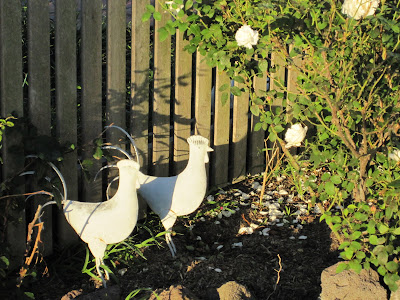
My ornamental birds, also gifts, are ready to move to Jindivick. They will be the only additions to the stunning garden I am moving to. I do remember when I moved to Bunyip finding the different plants that 'popped' up in the various seasons. I am excited about this happening again.
Packing and sorting 'stuff' is another matter. People are so quick with advice - 'if you have not worn it for 12 months you never will again so get rid of it'. Its so exciting finding things I had forgotten I owned. Of course they are not going to be given or thrown away! Now I remember I own them I just might wear them. 'De-clutter' - I have just looked it up in the dictionary and its not there!
There is a lot of stuff that has already been taken to the Posh Op Shop in Garfield - and there is more to come. No books though - I do not seem to be able to part with many of these.
I have found the answer! Tomorrow I have rented a storage unit in Warragul. Everything that I want to keep but does not have a 'home' at the new property, will go into store. I consider this is half way to getting rid of it!
Wednesday, May 5, 2010
Competition Edge
What makes a 'top' competitor? Is this different from being an 'elite' competitor? I believe the answer is 'yes'. One can be a top competitor at any level. The components are the same for any standard and any discipline. You have to be prepared - with mental preparation for riding a dressage test, show jumping or cross-country course.
Then you have to be able to keep your 'nerve' and your concentration.
You cannot say that a rider at Badminton is any more nervous than a rider at a local competition. Everything is relative to that rider. Part of keeping your 'nerve' is believing in yourself. Total concentration allows a rider to totally focus on the task of riding the 'course'. If you are using 60% of your thinking on other thoughts and emotions you only have 40% of your brain to compete with. This is clearly not enough!
Riders need to make a plan in minute detail and then be able to follow that plan. Then only a small percentage of the brain power is used up following the plan and this leaves brain to spare to 'perform'. Top performance is all about calculated risk. As horses have individual personalities it is not possible to totally predict their behaviours and reactions. Following a plan gives the rider time to assess the performance and make changes.
Prepare to succeed - and hold your nerve!
Subscribe to:
Comments (Atom)
